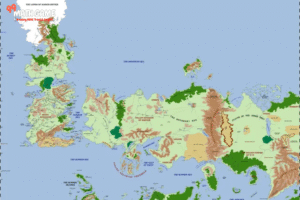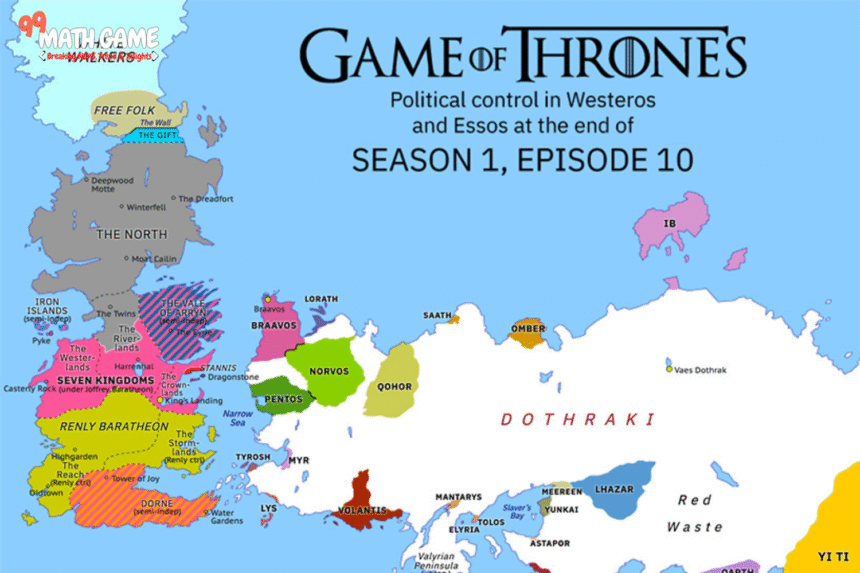This meticulously engineered map set brings the world of Westeros and Essos to life. The geography of George R.R. Martin’s fantasy epic is almost as complex as its political machinations, with every location serving a fateful purpose in the saga. These game of thrones map can help fans follow character journeys, visualize military campaigns, and absorb the world-building.
From the opening credits of HBO’s adaptation to the official book atlases, the maps are iconic. They have real-life inspirations mixed with fantasy elements, causing a realistic, yet magically induced ambience. For new viewers and longtime die-hards alike, digging into these maps exposes hidden connections and foreshadowing.
The best captures the grandeur and the gritty realism of Martin’s vision. Whether it is Jon Snow’s patrols atop the Wall or Daenerys’ victories in Slaver’s Bay, geography shapes almost every significant set piece in the series.
Quick Bio Table
| Category | Details |
|---|---|
| Fictional World Name | Known World (Westeros, Essos, Sothoryos, Ulthos) |
| Creator | George R.R. Martin |
| First Appearance | 1996 (A Game of Thrones novel) |
| Main Continents | Westeros, Essos |
| Notable Cities | King’s Landing, Winterfell, Braavos, Meereen |
| Longest Structure | The Wall (300 miles long, 700 feet tall) |
| Largest Desert | The Red Waste (Essos) |
| Longest River | The Trident (Westeros) |
| Highest Mountains | The Mountains of the Moon (Westeros) |
| Oldest Civilization | Valyrian Freehold |
| Most Isolated Region | The Shadow Lands (far east Essos) |
| Map Publication | “The Lands of Ice and Fire” (2012) |
| Show Adaptation | HBO’s animated opening title sequence |
The Seven Kingdoms of Westeros
From the frozen North to the fiery South, each culture, climate and people differ significantly in one of the few ways Westeros is broad. Ruled by House Stark from Winterfell, the North is the largest and least-populated region of the continent. Its most notable feature is the 700-foot-tall Wall, which defends the realm against the wildlings and White Walkers.
The bountiful Riverlands and Vale boast towering mountains and tactical river crossings that have won and lost so many battles. The capital, King’s Landing, is on Blackwater Bay, crowned with the Red Keep and fetid with slums. Farther south, Dorne’s arid setting and Mediterranean bells and whistles make it stand out among the kingdoms.
These geographical distinctions show why unification has been difficult, at best. Distances and the interplay between castles, winter travel difficulties and natural features of the land all affect the respective parties’ power.

Essos: The Eastern Continent
Essos is in sharp contrast to Westeros, with its endless grasslands, ancient cities, and peculiar cultures. The Dothraki inhabit the central plains, the “Dothraki Sea”, of Essos, a vast area that covers most of the continent’s centre. To the west are the Free Cities, such as Braavos and Pentos, with their own political and economic peculiarities.
(The slave-trading city of Meereen shares this pyramid-shaped structure and its business in human flesh with Astapor.) Eastward still are the remains of Valyria, a haunting testament to the dragonlords who have long since fallen. The “Queen of Cities,” Qarth, powers down the Jade Sea with its high walls and enigmatic warlocks.
Travelling with Daenerys across Essos shows how countries are formed by their geography. The enormous physical distance explains why Kings of Westeros seldom interfered in the affairs of the cities of Essos, and the Narrow Sea has ever been a barrier and a road between the two continents.
Beyond the Known World
Martin’s universe is larger than what most game of thrones map can contain. Another southern continent, Sothoryos, hasn’t been well-explored, but is believed to be filled with jungles full of dangerous animals. Maps showing Ulthos, far southeast of the continent, are rare, and little is known about it.
The Shadow Lands, further east still, are said to house magic that can bend the fabric of reality. These undiscovered territories are where Martin can gesture to a broader world without having to flesh out every inch of it. They are traders of strange goods, bizarre religions, and sometimes introduce danger to the ‘civilized’ world.
There’s something lovely about that vagueness: the story is told in a living, breathing world with its rich history. The areas around them could be seen more in future books or spin-offs.
Real-World Inspirations
Martin relied heavily on European history to create his universe. Westeros is an upside-down British Isles, as they are known to be, with Dorne playing the part of Spain and the North the part of Scotland and Scandinavia. The Wall runs parallel to Hadrian’s Wall, which the Romans constructed to fend off northern tribes.
The continent of Essos draws on several other cultures from the East. The Dothraki are like Mongol hordes, and the Free Cities are medieval Italian merchant city-states. The destruction of Valyria reminds us of the eruption of Mount Vesuvius, which entombed Pompeii, and the past and present of Rome’s empire.
These connections to the physical world also ground the fantasy aspect, lending the world a sense of reality. They also offer Martin the opportunity to continue examining historical concepts such as feudalism, colonialism, and the struggle of civilizations using the fictitious Westeros.
Evolution of the Maps
The original book maps were relatively simple, featuring only the significant locations. As the series became more popular, there were more detailed versions. HBO’s adaptation has used animated maps in its opening sequence, shifting the maps to feature the locations that become key in that episode.
The most detailed official mapping thus far is that found in “The Lands of Ice and Fire,” which was released in 2012. Fan-generated maps have also flourished online, some attempting to harmonise gaps between book and show geography. There are now interactive maps that allow you to follow a character’s movements through the series.
This evolution highlights the degree to which geography has become central to the Game of Thrones experience. Maps also serve as art that fans enjoy collecting and displaying.
Best Maps for Fans
The official “Lands of Ice and Fire” atlas is still the best option for collectors: It comes with a dozen large maps covering all critical areas of the continent. HBO Even HBO’s straightforwardly licensed merchandise couldn’t resist the flair, selling maps from the show rendered as fine-quality posters, all with neon-illuminated city markers.
There are also unique hand-drawn versions by Etsy artists, ranging from minimalist designs to lushly illustrated ones that include house sigils. Some fanciful maps reimagine Westeros in other styles, like a medieval portolan chart or a modern subway system diagram. Online features include clickable maps with lore information.
When deciding on a map, consider whether you would like your map to be accurate to the books of the show in terms of its appearance. Size and framing options also count in display. Many listeners love the idea of owning multiple editions to enjoy various artistic perspectives.
Maps and Rewatching – How Maps Can Make Rewatching Even Better
Follow the maps as you rewatch, and there are a lot of subtle storytelling tidbits to pick up on. You’ll see how the trip from King’s Landing to the Eyrie, when Tyrion makes it in, flinging himself through the Imp’s Door, leads through the Mountains of the Moon, or how the naval attack on King’s Landing that Stannis undertakes has to follow the geography of Blackwater Bay.
The maps also tell us that being trapped between two rivers would mean that Robb Stark would have been allowed to cross the Twins to mount an invasion of the South. They also explain why some areas stay isolated (like the Vale) or vulnerable (like the Riverlands). It is therefore much easier to comprehend travel times and military operations if distances between places are tracked.
For book readers, mapping can be a way to read “foreshadowing” vis-a-vis the text. Some castles are located close to each other, and the course of larger rivers and the spatial arrangement of cities often foreshadow plot developments for the sports-savvy from the attentive audience.

Contribution of the Map to Fan Theories
Geography: Many popular fan theories emphasize geography. For instance, the real physical location of the Tower of Joy is a driving force behind the debate over who Jon Snow’s parents are. The manner in which the crypts of Winterfell are arranged has prompted speculation about secret Stark mysteries.
Some theorists examine ancient Valyrian roads to guess where dragons may reappear. Still others study the coast’s geography to predict where new invaders might land. Those ”Here there be dragons” unknown zones on the map also encourage speculation about what future stories will bring.
These theories show how much fans get into Martin’s intricate world-building. The maps themselves double as puzzles to unravel, as every mountain range and island could potentially contain clues to the mysteries of the saga.
READ MORE: OVO Game Unblocked: How to Play, Best Sites, and Tips
FAQs
How well do the maps shown in Game of Thrones represent the books?
The show played fast and loose with the geography, but the maps in the official books are the most accurate (you heard me) representation of Martin’s world.
Where can I buy premium Game of Thrones maps?
Your best sources are probably the unofficial “Lands of Ice and Fire” atlas, HBO’s merchandise store, and specialty sellers on Etsy.
Which real places are Westeros and Essos based on?
Westeros is the result of blending British and European geography, with 1/3rd of its land being sand deserts. Essos has foreign cultures inspired by Middle Eastern, Mediterranean and Central Asian cultures.
How are certain places, such as Sothoryos, so little known?
The gods knew Martin intentionally kept some parts hidden to create a sense of wonder and to give future stories room to expand.
How large is Westeros in comparison to real-life continents?
Martin has described Westeros as approximately the size of South America, but has kept the scale somewhat flexible.






